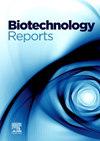Quorum quenching: A key biological activity of marine actinobacteria extracts for acne vulgaris control
Q1 Immunology and Microbiology
引用次数: 0
Abstract
Quorum sensing (QS) regulates virulence factors in bacteria associated with acne vulgaris. Consequently, extracts from marine actinobacteria sourced from Colombian Caribbean sponges and octocorals were screened for quorum quenching (QQ) and anti-biofilm activity. The most promising extract, G12.218 from Promicromonospora sp. CLIVUS-G12218, inhibited QS by 97 % via AI-2 signaling in Vibrio harveyi BB170 and reduced Staphylococcus aureus biofilm by 60 % at 3 mg/L, without cytotoxicity to keratinocytes and fibroblasts.
Untargeted metabolomics of QQ active and non-active extracts revealed distinct profiles enriched in terpenoids, phenols, and butenolides, potentially linked to bioactivity. These extracts also exhibited antioxidant capacity (18 ± 0.23 µmol TE/L) and hyaluronidase inhibition up to 72.8 %, suggesting skin-protective properties. These findings highlight the potential of marine actinobacteria as a source of QQ and anti-biofilm agents for acne therapy and skincare.

群体猝灭:海洋放线菌提取物控制寻常痤疮的关键生物活性
群体感应(QS)调节与寻常痤疮相关的细菌的毒力因子。因此,对来自哥伦比亚加勒比海绵和八鳃珊瑚的海洋放线菌提取物进行了群体猝灭(QQ)和抗生物膜活性的筛选。最有希望的提取物是原小单孢菌(Promicromonospora sp. CLIVUS-G12218),在3 mg/L浓度下,通过哈维弧菌BB170的AI-2信号传导抑制QS 97%,减少金黄色葡萄球菌生物膜60%,对角质形成细胞和成纤维细胞无细胞毒性。QQ活性和非活性提取物的非靶向代谢组学显示出不同的萜类、酚类和丁烯内酯富集谱,这可能与生物活性有关。这些提取物还具有抗氧化能力(18±0.23µmol TE/L)和高达72.8%的透明质酸酶抑制作用,表明其具有皮肤保护作用。这些发现突出了海洋放线菌作为QQ和抗生物膜剂用于痤疮治疗和护肤的潜力。
本文章由计算机程序翻译,如有差异,请以英文原文为准。
求助全文
约1分钟内获得全文
求助全文
来源期刊

Biotechnology Reports
Immunology and Microbiology-Applied Microbiology and Biotechnology
CiteScore
15.80
自引率
0.00%
发文量
79
审稿时长
55 days
期刊介绍:
Biotechnology Reports covers all aspects of Biotechnology particularly those reports that are useful and informative and that will be of value to other researchers in related fields. Biotechnology Reports loves ground breaking science, but will also accept good science that can be of use to the biotechnology community. The journal maintains a high quality peer review where submissions are considered on the basis of scientific validity and technical quality. Acceptable paper types are research articles (short or full communications), methods, mini-reviews, and commentaries in the following areas: Healthcare and pharmaceutical biotechnology Agricultural and food biotechnology Environmental biotechnology Molecular biology, cell and tissue engineering and synthetic biology Industrial biotechnology, biofuels and bioenergy Nanobiotechnology Bioinformatics & systems biology New processes and products in biotechnology, bioprocess engineering.
 求助内容:
求助内容: 应助结果提醒方式:
应助结果提醒方式:


